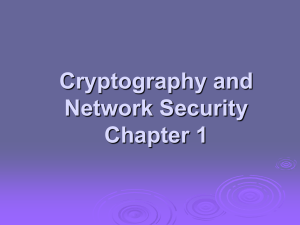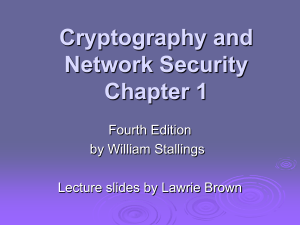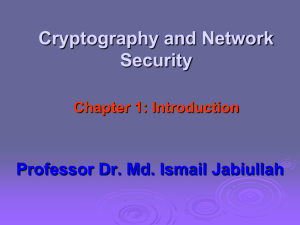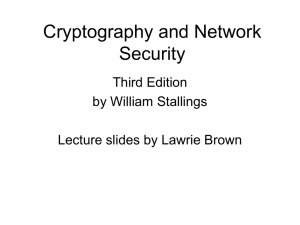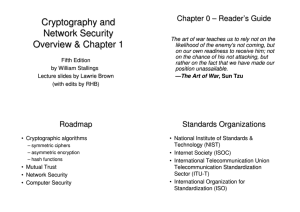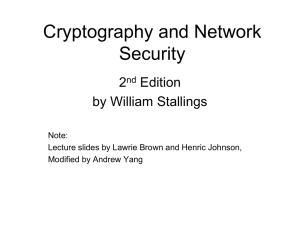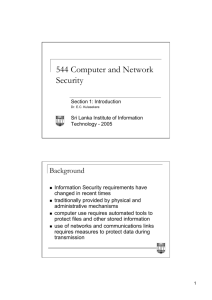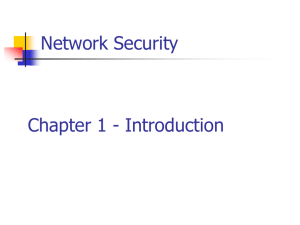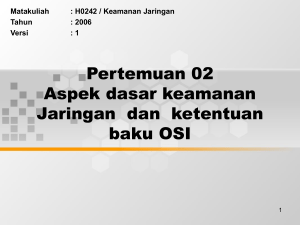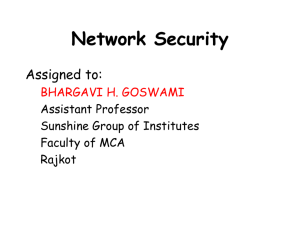Lectures 1, 2 and part of 3 (partial)
advertisement
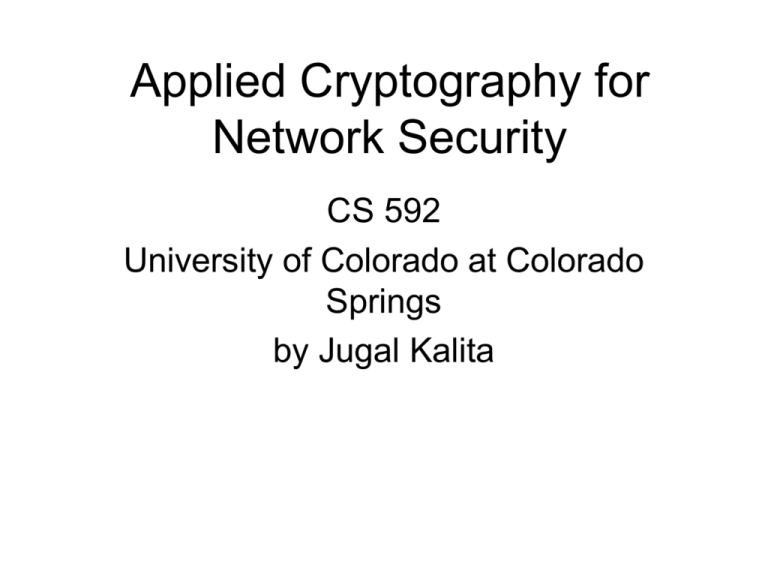
Applied Cryptography for Network Security CS 592 University of Colorado at Colorado Springs by Jugal Kalita Background • Information is a difficult term to define • Most valuable information is stored on computers these days • Use of networks and communications links requires measures to protect data during storage and transmission Aim of Course • Our focus is on Internet Security, i.e, security of information on computers connected to the Internet • Consists of measures to deter, prevent, detect, and correct security violations that involve the transmission of information Services, Mechanisms, Attacks • Need a systematic way to define security requirements of a system • We consider three aspects of information security: – security attacks – security mechanisms – security services • We consider them in reverse order Security Service – A security service is something that enhances the security of data processing systems and information transfers of an organization – A security service is intended to counter security attacks – A security service makes use of one or more security mechanisms to provide the service – A security service replicates functions normally associated with physical documents • eg. have signatures, dates; need protection from disclosure, tampering, or destruction; be notarized or witnessed; be recorded or licensed Security Mechanism • It is a mechanism that is designed to detect, prevent, or recover from a security attack • No single mechanism that can support all functions required • One particular element underlies many of the security mechanisms in use: cryptographic techniques Security Attack • A security attack is any action that compromises the security of information owned by an organization • Information security is about how to prevent attacks, or failing that, to detect attacks on information-based systems • There are a wide range of attacks OSI Security Architecture • ITU-T (International Telecommunication Union, Telecommunication Standardization Sector) X.800 Security Architecture for OSI • It provides a systematic way of defining and providing security requirements • It provides a useful, if abstract, overview of concepts we are going to study Security Services • X.800 defines a security service as: a service provided by a protocol layer of communicating open systems, which ensures adequate security of the systems or of data transfers • RFC 2828 defines it as: a processing or communication service provided by a system to give a specific kind of protection to system resources • X.800 categorizes security services into 5 major categories Security Services (X.800) • Authentication - assurance that the • • • • communicating entity is the one claimed Access Control - prevention of the unauthorized use of a resource Data Confidentiality –protection of data from unauthorized disclosure Data Integrity - assurance that data received is as sent by an authorized entity Non-Repudiation - protection against denial by one of the parties in a communication Security Mechanisms (X.800) • Specific security mechanisms: – encipherment, digital signatures, access controls, data integrity, authentication exchange, traffic padding, routing control, notarization • Pervasive security mechanisms: – trusted functionality, security labels, event detection, security audit trails, security recovery Classify Security Attacks as • Passive attacks - eavesdropping on, or monitoring of transmissions to: – obtain message contents, or – monitor traffic flows • Active attacks – modification of data stream to: – masquerade of one entity as some other – replay previous messages – modify messages in transit – denial of service Model for Network Security Model for Network Security • Using this model requires us to: – design a suitable algorithm for the security transformation – generate the secret information (keys) used by the algorithm – develop methods to distribute and share the secret information – specify a protocol enabling the principals to use the transformation and secret information for a security service Model for Network Access Security Model for Network Access Security • Using this model requires us to: – select appropriate gatekeeper functions to identify users – implement security controls to ensure only authorized users access designated information or resources • Trusted computer systems can be used to implement this model Summary • Topics Discussed: – Need for Internet security – Security services, mechanisms, attacks – X.800 standard – models for network (access) security
